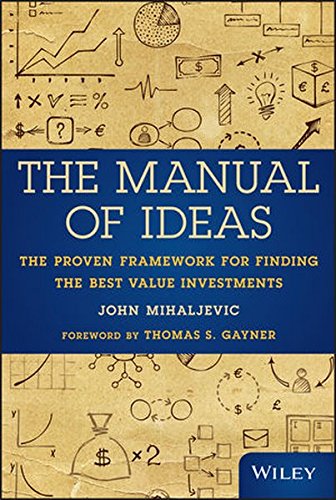Book Reviews | Why Pender?
Pender Book Review: The Manual of Ideas: The Proven Framework for Finding the Best Value Investments

 I read The Manual of Ideas a few years ago, but gave myself a refresher over the summer. I am currently at Latticework, an event put on by The Manual of Ideas community, where leading investors come to speak on several of the topics discussed below.
I read The Manual of Ideas a few years ago, but gave myself a refresher over the summer. I am currently at Latticework, an event put on by The Manual of Ideas community, where leading investors come to speak on several of the topics discussed below.
Of particular interest since I first read the book has been the continued proliferation of ETFs and the popularity of passive investing. For those of us still searching out alpha in a world moving to passive strategies (according to mass media), the discussion on parts of the market where opportunities still exist is timely.
The author, John Mihaljevic, is the Managing Editor, The Manual of Ideas and Managing Director, ValueConferences, both of which are online resources for value investors – amateur and professional. Having amassed a truly unique archive of interviews with over 100 Fund Managers, this book collates and distills these ideas into “the definitive source for value investing ideas from the brightest minds in the business.” Felix and I had the pleasure of presenting two ideas at the most recent Wide-Moat Investing Summit in July 2017.
I’ve read a lot of books about value investing and, in short, I recommend The Manual of Ideas to everyone. It’s a really good book on value investing. Not only is it interesting but I came away with some new insights, also some clarification on the way I look at certain things, as well as ratification in other areas. Best of all, I think this is a really accessible book for all, whatever level of investor you are.
The book is ten chapters long. And I found Chapters 4, 5, 7, 8, and 9 to be the more interesting and relevant to me in what I do.
- Chapter 4 talks about investing in good companies at a cheap price and comes at it from the perspective of Joel Greenblatts’ methodology in The Little Book that Beats the Market. In doing so, it touches on stocks that we at Pender call “compounders”.
- Chapter 5 examines Jockey Stocks and the quality of management teams, with some of our favourite topics including integrity, incentives, ability to allocate capital and track record.
- Chapter 7 focuses on the opportunity in small caps. Of particular interest is a discussion about how traditional screening is not as useful for small cap companies due to their size.
- Chapter 8 considers special situations or event-driven situations and why it’s such an interesting part of the market. In certain situations, the timing of events is much more important as it can have a higher correlation to generating returns than the market factors at play.
- Chapter 9 explores equity stubs and breaks them into two groups: Public market private equity deals, and distressed situations. Given our experience in both, this chapter is very much worth a read. It also mentions the importance of position sizing with equity stubs because your payoff can be so high. That said, a lot of times your probability of being correct is less than 50% and there is the real possibility for permanent impairment of capital. Therefore, make a smaller bet sizes.
One of my key takeaways from Chapters 7, 8 and 9 was that these were definitely parts of the market where you can get an analytical edge. Analytical edges that can deliver alpha are more likely to occur in market niches where there is a large dispersion of returns. Clearly small cap, special sits and equity stubs fit into this category.



